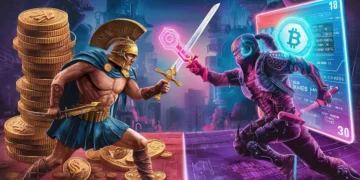The internet has undergone significant changes since its inception, evolving from a static collection of web pages to a dynamic and interactive space. Web3 represents the next step in this evolution, where decentralization, blockchain technology, and user empowerment will redefine how we interact with digital platforms. This article explores the concept of Web3, its implications for the internet, and how technologies like blockchain and cryptocurrencies play a pivotal role in shaping this new era.
What is Web3?
Web3, often referred to as the decentralized web, represents a shift away from the traditional centralized systems of the internet. In Web2, the dominant model, data and control are largely owned by centralized entities like Google, Facebook, and Amazon. These companies collect vast amounts of user data, which they monetize, often without transparency or user consent. Web3 aims to give users more control over their data, interactions, and digital identities by leveraging decentralized networks and technologies such as blockchain.
At its core, Web3 is built on the principles of decentralization, user ownership, and transparency. It enables users to engage with online services without relying on intermediaries, allowing for peer-to-peer transactions, decentralized applications (dApps), and ownership of digital assets. This paradigm shift could disrupt various industries, from finance and gaming to social media and online marketplaces.
The Role of Blockchain in Web3
Blockchain technology lies at the heart of Web3. A blockchain is a distributed ledger that records transactions across multiple computers, ensuring that the data is immutable and transparent. In the context of Web3, blockchain allows for the creation of decentralized applications (dApps) and services that don’t rely on centralized servers or institutions.
One of the most well-known applications of blockchain is cryptocurrencies, such as Bitcoin and Ethereum. These digital currencies are built on blockchain networks, where transactions are verified and recorded by participants in the network (known as miners or validators) without the need for a central authority like a bank. This decentralization ensures that transactions are secure, transparent, and resistant to censorship.
For Web3 to reach its full potential, blockchain networks must scale to accommodate millions, if not billions, of users. Platforms like Ethereum, Solana, and Polkadot are working to improve scalability, transaction speed, and interoperability, which are essential for Web3’s widespread adoption.
Decentralized Finance (DeFi) and Web3
One of the most exciting aspects of Web3 is its potential to revolutionize the financial industry through decentralized finance (DeFi). DeFi refers to a set of financial services, such as lending, borrowing, and trading, that are built on blockchain networks. Unlike traditional finance, which relies on banks and other intermediaries, DeFi platforms operate in a peer-to-peer manner, removing the need for third-party institutions.
For example, platforms like Aave and Compound allow users to lend and borrow cryptocurrencies directly from each other, with the help of smart contracts. These self-executing contracts automatically enforce the terms of the agreement without the need for a trusted intermediary. Additionally, decentralized exchanges (DEXs) like Uniswap enable users to trade cryptocurrencies directly, without relying on centralized exchanges like Coinbase or Binance.
DeFi has the potential to democratize access to financial services, especially in regions where traditional banking is limited or inaccessible. By removing intermediaries and providing greater transparency, DeFi can offer lower fees, faster transactions, and increased financial inclusion.
Non-Fungible Tokens (NFTs) and Web3
Another key component of Web3 is the rise of non-fungible tokens (NFTs). NFTs are unique digital assets that represent ownership or proof of authenticity of a specific item or piece of content. Unlike cryptocurrencies, which are interchangeable, NFTs are one-of-a-kind and cannot be replicated or replaced. NFTs are primarily used in the art, gaming, and entertainment industries, but their potential extends far beyond these sectors.
In the context of Web3, NFTs enable users to have true ownership of digital assets, such as art, music, videos, and virtual real estate. This ownership is secured by blockchain technology, ensuring that the item cannot be copied or tampered with. Additionally, NFTs can be bought, sold, and traded on decentralized marketplaces like OpenSea, allowing creators to monetize their work directly without the need for intermediaries.
For example, an artist can create a digital artwork and tokenize it as an NFT, allowing collectors to purchase and own the artwork. The artist can also set royalties, ensuring they receive a percentage of future sales whenever the NFT is resold. This shift empowers creators and gives them more control over how their work is distributed and monetized.
Moreover, NFTs are playing a pivotal role in virtual worlds and the metaverse. Platforms like Decentraland and Cryptovoxels enable users to buy, sell, and trade virtual land and assets as NFTs, creating new opportunities for digital ownership and expression. As Web3 continues to develop, NFTs could become a critical component of how we interact with the digital world.
Decentralized Identity and Data Ownership
In Web3, users have more control over their digital identity and personal data. Rather than relying on centralized platforms to manage login credentials and profile information, Web3 introduces the concept of decentralized identity (DID). A DID allows users to own and control their digital identity, ensuring privacy and security across various platforms and services.
For example, instead of using a Google or Facebook login to access a service, users can authenticate themselves with a decentralized identity that they control. This eliminates the need for centralized entities to collect and store sensitive personal information, reducing the risk of data breaches and privacy violations.
Additionally, Web3 emphasizes data ownership. In the current Web2 model, companies collect vast amounts of data from users, often without their explicit consent or knowledge. In Web3, users have the ability to control and monetize their data, choosing who can access it and under what conditions. This shift could lead to a more transparent and user-centric internet, where individuals have more control over their personal information.
The Role of Proxies in Web3 Security
As Web3 grows and attracts more users, security becomes a critical concern. Since Web3 platforms are decentralized and rely on blockchain technology, they are often targeted by hackers and malicious actors. In this context, ensuring user privacy and data protection is vital.
One way to enhance security in Web3 applications is through the use of proxies, such as a residential proxy with free trial. A residential proxy routes internet traffic through real residential IP addresses, making it harder for malicious actors to track or block users. By using a residential proxy, Web3 users can protect their online privacy while interacting with decentralized applications, ensuring that their personal information remains secure.
Additionally, proxies can help users bypass geographic restrictions and access Web3 platforms that may be blocked or limited in certain regions. By masking their IP addresses and using a residential proxy with free trial, users can maintain anonymity and freedom while exploring the decentralized web.
Challenges and the Road Ahead
While Web3 presents exciting opportunities, it also faces several challenges. One of the biggest hurdles is scalability. Current blockchain networks, such as Ethereum, can only handle a limited number of transactions per second, which can lead to congestion and high fees. To overcome this, developers are working on solutions like Ethereum 2.0, layer-2 scaling solutions, and alternative blockchains to improve transaction speed and reduce costs.
Another challenge is the user experience. For many people, interacting with blockchain networks and decentralized applications can be complicated and intimidating. Wallets, private keys, and gas fees are terms that may be unfamiliar to those used to traditional web platforms. Simplifying the user experience and making Web3 more accessible will be crucial for its mass adoption.
Finally, there are regulatory and legal concerns surrounding Web3. Governments and institutions are still trying to figure out how to regulate decentralized platforms, cryptocurrencies, and NFTs. As Web3 grows, lawmakers will need to establish clear frameworks to ensure that these technologies are used responsibly and safely.
Conclusion
Web3 represents a fundamental shift in how we interact with the internet, empowering users to take control of their data, digital identities, and assets. By leveraging blockchain technology, decentralized finance, NFTs, and other innovations, Web3 is creating new opportunities for innovation, ownership, and privacy.
While challenges remain, the potential of Web3 is immense. As the decentralized web continues to evolve, it will reshape industries, democratize access to services, and provide a more open, secure, and transparent internet. By embracing technologies like blockchain and using tools such as a residential proxy with free trial, users can help secure their online experiences and contribute to the growth of Web3.
The internet has undergone significant changes since its inception, evolving from a static collection of web pages to a dynamic and interactive space. Web3 represents the next step in this evolution, where decentralization, blockchain technology, and user empowerment will redefine how we interact with digital platforms. This article explores the concept of Web3, its implications for the internet, and how technologies like blockchain and cryptocurrencies play a pivotal role in shaping this new era.
What is Web3?
Web3, often referred to as the decentralized web, represents a shift away from the traditional centralized systems of the internet. In Web2, the dominant model, data and control are largely owned by centralized entities like Google, Facebook, and Amazon. These companies collect vast amounts of user data, which they monetize, often without transparency or user consent. Web3 aims to give users more control over their data, interactions, and digital identities by leveraging decentralized networks and technologies such as blockchain.
At its core, Web3 is built on the principles of decentralization, user ownership, and transparency. It enables users to engage with online services without relying on intermediaries, allowing for peer-to-peer transactions, decentralized applications (dApps), and ownership of digital assets. This paradigm shift could disrupt various industries, from finance and gaming to social media and online marketplaces.
The Role of Blockchain in Web3
Blockchain technology lies at the heart of Web3. A blockchain is a distributed ledger that records transactions across multiple computers, ensuring that the data is immutable and transparent. In the context of Web3, blockchain allows for the creation of decentralized applications (dApps) and services that don’t rely on centralized servers or institutions.
One of the most well-known applications of blockchain is cryptocurrencies, such as Bitcoin and Ethereum. These digital currencies are built on blockchain networks, where transactions are verified and recorded by participants in the network (known as miners or validators) without the need for a central authority like a bank. This decentralization ensures that transactions are secure, transparent, and resistant to censorship.
For Web3 to reach its full potential, blockchain networks must scale to accommodate millions, if not billions, of users. Platforms like Ethereum, Solana, and Polkadot are working to improve scalability, transaction speed, and interoperability, which are essential for Web3’s widespread adoption.
Decentralized Finance (DeFi) and Web3
One of the most exciting aspects of Web3 is its potential to revolutionize the financial industry through decentralized finance (DeFi). DeFi refers to a set of financial services, such as lending, borrowing, and trading, that are built on blockchain networks. Unlike traditional finance, which relies on banks and other intermediaries, DeFi platforms operate in a peer-to-peer manner, removing the need for third-party institutions.
For example, platforms like Aave and Compound allow users to lend and borrow cryptocurrencies directly from each other, with the help of smart contracts. These self-executing contracts automatically enforce the terms of the agreement without the need for a trusted intermediary. Additionally, decentralized exchanges (DEXs) like Uniswap enable users to trade cryptocurrencies directly, without relying on centralized exchanges like Coinbase or Binance.
DeFi has the potential to democratize access to financial services, especially in regions where traditional banking is limited or inaccessible. By removing intermediaries and providing greater transparency, DeFi can offer lower fees, faster transactions, and increased financial inclusion.
Non-Fungible Tokens (NFTs) and Web3
Another key component of Web3 is the rise of non-fungible tokens (NFTs). NFTs are unique digital assets that represent ownership or proof of authenticity of a specific item or piece of content. Unlike cryptocurrencies, which are interchangeable, NFTs are one-of-a-kind and cannot be replicated or replaced. NFTs are primarily used in the art, gaming, and entertainment industries, but their potential extends far beyond these sectors.
In the context of Web3, NFTs enable users to have true ownership of digital assets, such as art, music, videos, and virtual real estate. This ownership is secured by blockchain technology, ensuring that the item cannot be copied or tampered with. Additionally, NFTs can be bought, sold, and traded on decentralized marketplaces like OpenSea, allowing creators to monetize their work directly without the need for intermediaries.
For example, an artist can create a digital artwork and tokenize it as an NFT, allowing collectors to purchase and own the artwork. The artist can also set royalties, ensuring they receive a percentage of future sales whenever the NFT is resold. This shift empowers creators and gives them more control over how their work is distributed and monetized.
Moreover, NFTs are playing a pivotal role in virtual worlds and the metaverse. Platforms like Decentraland and Cryptovoxels enable users to buy, sell, and trade virtual land and assets as NFTs, creating new opportunities for digital ownership and expression. As Web3 continues to develop, NFTs could become a critical component of how we interact with the digital world.
Decentralized Identity and Data Ownership
In Web3, users have more control over their digital identity and personal data. Rather than relying on centralized platforms to manage login credentials and profile information, Web3 introduces the concept of decentralized identity (DID). A DID allows users to own and control their digital identity, ensuring privacy and security across various platforms and services.
For example, instead of using a Google or Facebook login to access a service, users can authenticate themselves with a decentralized identity that they control. This eliminates the need for centralized entities to collect and store sensitive personal information, reducing the risk of data breaches and privacy violations.
Additionally, Web3 emphasizes data ownership. In the current Web2 model, companies collect vast amounts of data from users, often without their explicit consent or knowledge. In Web3, users have the ability to control and monetize their data, choosing who can access it and under what conditions. This shift could lead to a more transparent and user-centric internet, where individuals have more control over their personal information.
The Role of Proxies in Web3 Security
As Web3 grows and attracts more users, security becomes a critical concern. Since Web3 platforms are decentralized and rely on blockchain technology, they are often targeted by hackers and malicious actors. In this context, ensuring user privacy and data protection is vital.
One way to enhance security in Web3 applications is through the use of proxies, such as a residential proxy with free trial. A residential proxy routes internet traffic through real residential IP addresses, making it harder for malicious actors to track or block users. By using a residential proxy, Web3 users can protect their online privacy while interacting with decentralized applications, ensuring that their personal information remains secure.
Additionally, proxies can help users bypass geographic restrictions and access Web3 platforms that may be blocked or limited in certain regions. By masking their IP addresses and using a residential proxy with free trial, users can maintain anonymity and freedom while exploring the decentralized web.
Challenges and the Road Ahead
While Web3 presents exciting opportunities, it also faces several challenges. One of the biggest hurdles is scalability. Current blockchain networks, such as Ethereum, can only handle a limited number of transactions per second, which can lead to congestion and high fees. To overcome this, developers are working on solutions like Ethereum 2.0, layer-2 scaling solutions, and alternative blockchains to improve transaction speed and reduce costs.
Another challenge is the user experience. For many people, interacting with blockchain networks and decentralized applications can be complicated and intimidating. Wallets, private keys, and gas fees are terms that may be unfamiliar to those used to traditional web platforms. Simplifying the user experience and making Web3 more accessible will be crucial for its mass adoption.
Finally, there are regulatory and legal concerns surrounding Web3. Governments and institutions are still trying to figure out how to regulate decentralized platforms, cryptocurrencies, and NFTs. As Web3 grows, lawmakers will need to establish clear frameworks to ensure that these technologies are used responsibly and safely.
Conclusion
Web3 represents a fundamental shift in how we interact with the internet, empowering users to take control of their data, digital identities, and assets. By leveraging blockchain technology, decentralized finance, NFTs, and other innovations, Web3 is creating new opportunities for innovation, ownership, and privacy.
While challenges remain, the potential of Web3 is immense. As the decentralized web continues to evolve, it will reshape industries, democratize access to services, and provide a more open, secure, and transparent internet. By embracing technologies like blockchain and using tools such as a residential proxy with free trial, users can help secure their online experiences and contribute to the growth of Web3.





















































































get generic clomiphene online buying clomiphene buy cheap clomiphene without dr prescription where to get clomiphene without prescription clomid chance of twins cost of generic clomiphene pills clomiphene price walmart
I couldn’t hold back commenting. Adequately written!
This is the make of delivery I recoup helpful.
order generic azithromycin – buy floxin 400mg brand flagyl
buy semaglutide 14 mg generic – cyproheptadine order online buy periactin medication
buy motilium pills – purchase flexeril cheap cyclobenzaprine
order inderal 20mg online – buy generic methotrexate over the counter buy methotrexate 10mg for sale
azithromycin pill – buy nebivolol 5mg sale bystolic 5mg tablet
augmentin 1000mg over the counter – https://atbioinfo.com/ order ampicillin generic
brand esomeprazole – https://anexamate.com/ buy nexium 40mg online
warfarin 2mg usa – coumamide order cozaar 50mg pill
mobic 7.5mg pill – https://moboxsin.com/ mobic 7.5mg ca
purchase deltasone online – corticosteroid deltasone 5mg without prescription
male ed drugs – fast ed to take site best ed drug
brand amoxil – combamoxi purchase amoxil without prescription
forcan over the counter – purchase diflucan generic diflucan brand
cenforce pills – https://cenforcers.com/# brand cenforce
cialis sublingual – tadalafil buy online canada how much does cialis cost at walgreens
zantac price – online zantac 150mg brand
what are the side effects of cialis – https://strongtadafl.com/ maximum dose of cialis in 24 hours
More posts like this would bring about the blogosphere more useful. cenforce 100 espaГ±ol
viagra sale ottawa – cheapest viagra buy cheap viagra where can i buy viagra in la
Thanks an eye to sharing. It’s outstrip quality. https://ursxdol.com/clomid-for-sale-50-mg/
The reconditeness in this tune is exceptional. https://prohnrg.com/product/atenolol-50-mg-online/
I couldn’t weather commenting. Well written! stromectol posologie poids
Good blog you procure here.. It’s obdurate to espy strong calibre belles-lettres like yours these days. I truly respect individuals like you! Go through vigilance!! https://ondactone.com/spironolactone/